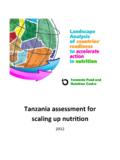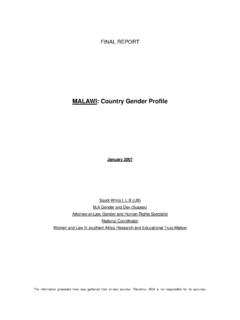Transcription of 2. Generating Economic Benefi ts with Improved …
1 2. Generating Economic Benefits with Improved water Resources management and services Photo: Dr. Katrin Teubner Society's Economic sectors, including agriculture, access to Improved water supply. A increase in The interaction between industry and services , rely on water resources and investment in household access to safe water is associ- Improved water supply related services . Improved access to water services ated with a 1% increase in GDP8. This report argues and sanitation and and Improved management of water resources con- that Improved water services and water resources man- Economic growth is tribute substantially to Economic growth through in- agement are an essential and necessary condition for mutually reinforcing and creasing business productivity and development. It Economic development and growth. However, it is also has the potential to start also improves human health, productivity and dignity clear that the interaction runs both ways.
2 Economic a virtuous cycle that considerably. growth itself can also drive increasing investments in improves the lives of There is a positive correlation between increased Improved water management and services . Thus, it poor people. national income and the proportion of population with can be argued that the interaction between Improved Making water a Part of Economic Development . water supply and sanitation and Economic growth is level, the section looks at interventions of improving mutually reinforcing and has the potential to start a vir- water resources management for agricultural and tuous cycle that improves the lives of poor people. food production and industry and its role in Economic The following section brings attention to water growth and development. Furthermore, a selection management and services interventions and benefits of cross cutting themes is considered, such as multi- at different levels.
3 At the individual/household level, purpose water storage capacity, eco-system services enormous savings in time and increased livelihood and floods and droughts. Here, the section provides opportunities for the poor are gained through im- insight into the complex role water plays in supporting proved access. Interventions also give sectoral and society, Economic growth and our ecosystems. cross-sectoral Economic benefits. At an aggregated Improved Access to water services and Basic Sanitation for Economic Development Key Points ated with having water and sanitation facilities The public and private investment needed to closer to home. Time saved due to less illness improve sanitation and water services contrib- and closer access to facilities translates into utes significantly to better health, Economic higher productivity and higher school attend- growth and eradicating poverty.
4 Increased ance. The total annual Economic benefit of productivity and production accrued at the reaching the MDG on water and sanitation individual/household level are augmented by amounts to USD 84 billion. Economic , health and education gains. In China, the total welfare loss from the impact The Economic benefits are immediate and of water pollution on health alone is estimated long-term. Immediate benefits include averted to USD billion for the late 1990s. health-related costs, and time savings associ- Immediate Benefits of water , sanitation and hygiene. million people die Improved Human Health every year from diarrhoeal disease; 90% of whom are The lack of access to safe water , basic sanitation and children under the age of 510. 133 million people suffer good hygiene practices is the third most significant risk from high intensity intestinal helminth infections (Ascaria- factor for poor health in developing countries with high sis, Trichuriasis, Hookworm disease) which often leads mortality rates9.
5 Diarrhoeal disease, for example, is to severe consequenses such as cognitive impairment, widely recognised as the principal result of inadequate massive dysentery, or anaemia. Box 2 The mosquito vectors that transmit this virus breed in Dengue and Dengue Haemorrhagic Fever small water collections in and around the house, in Some billion people two fifths of the world's particular in drinking water vessels. Improving the population are now at risk from dengue. WHO reliability of piped drinking water would remove the currently estimates 50 million cases of Dengue necessity to store water in or near their homes. These infection and 19,000 deaths worldwide every home water storage facilities are often designed year. Dengue in its haemorrhagic form is particu- without taking the dengue risks into consideration larly deadly for children.
6 The global prevalence of and have in some countries contributed to the exac- Dengue has grown dramatically in recent decades erbation of the transmission. The direct costs of den- and the disease is now endemic in more than gue varies from one year to the other in relation to 100 countries in Africa, the Americas, the Eastern the intensity of outbreaks, but the hidden costs to the Mediterranean, South-east Asia and the Western health services are considerable: in some outbreak Pacific. Southeast Asia and the Western Pacific are situations almost all the hospital beds are occupied most seriously affected. by Dengue patients. Source: WHO (2002b). Making water a Part of Economic Development . Box 3 Schistosomiasis The benefits of preventive action provide another way Poor people in Africa An estimated 160 million people are infected to consider the immediate Economic impacts of water spend at least a third with Schistosomiasis.
7 Quality and sanitation. Consider the cholera epidemic of their incomes on the The disease causes tens of thousands of deaths that swept Peru in 1991 that cost USD 1 billion to treat. treatment of water -relat- every year, mainly in sub-Saharan Africa. It is estimated that USD 100 million or a tenth of ed diseases like malaria It is strongly related to unsanitary excreta what was actually spent could have prevented the and diarrhoea. disposal and absence of nearby sources of epidemic. Adding to this the monetary expenses, the safe water . value of lost working days, and the lives lost, and Basic sanitation reduces the disease the cost-benefit ratio of preventive investments in water by up to 77%. and sanitation become astronomical12. Man-made reservoirs and poorly designed Evidence shows that Improved water supply and irrigation schemes are main drivers of Schisto- sanitation facilities and better hygiene behaviour will somiasis expansion and intensification radically reduce population illness.
8 Improved water Source: WHO (2004) supply can reduce diarrhoea morbidity by up to 25%. if severe outcomes are included13. Improved sanita- tion reduces diarrhoea morbidity by 32%. Hygiene interventions including hygiene education and pro- Box 4 Trachoma motion of hand washing can reduce the number of 500 million people are at risk from Trachoma. diarrhoeal cases by up to 45%14. Additional improve- 146 million are threatened by blindness. ments to drinking water quality at home, such as point- 6 million people are visually impaired by use of disinfection, are simple and cheap measures that Trachoma. make an immediate difference to the lives of those worst The disease is strongly related to lack of face affected. These interventions can lead to a reduction of washing, often due to absence of nearby diarrhoea episodes of up to 39%.
9 Sources of safe water . Improving access to safe water sources and better hygiene practices can reduce Tracho- ma morbidity by 27%. Source: WHO (2004). Box 5 What is a DALY? The Disability Adjusted Life Year is a summary meas- ure of population health, and one DALY represents one year of healthy life lost. The DALY is used to estimate the gap between the current health status of a population and an ideal situation where eve- ryone in that population would live to old age in full health. For each ill health phenomenon, DALYs are calculated on a population scale as the sum of both years lost due to premature mor- tality and the healthy years lost due to disability. Source: WHO (2002). Sub-Sahara Africa is where better management of wa- ter resources and improving access to water and sani- tation will have a particularly big impact.
10 Poor people Photo: Mats Lannerstad in Africa spend at least a third of their incomes on the treatment of water -related diseases like malaria and diarrhoea. The cost of the productive time lost due to these diseases, as well as widespread human suffering must also be added to this11. Making water a Part of Economic Development . Sub-Saharan Africa is a stark example of how water otherwise how much would it cost to avoid one and sanitation has a very significant impact on the year of healthy life lost. For various interventions, the lives of poor people. Consider that in rural areas review concluded with the following estimated costs women spend up to 6 hours a day on water collec- per DALY saved: tion chores. People also spend considerable time in Hygiene behaviour change: USD 20 per DALY. queuing for public toilets or finding a safe place to saved defecate.
















